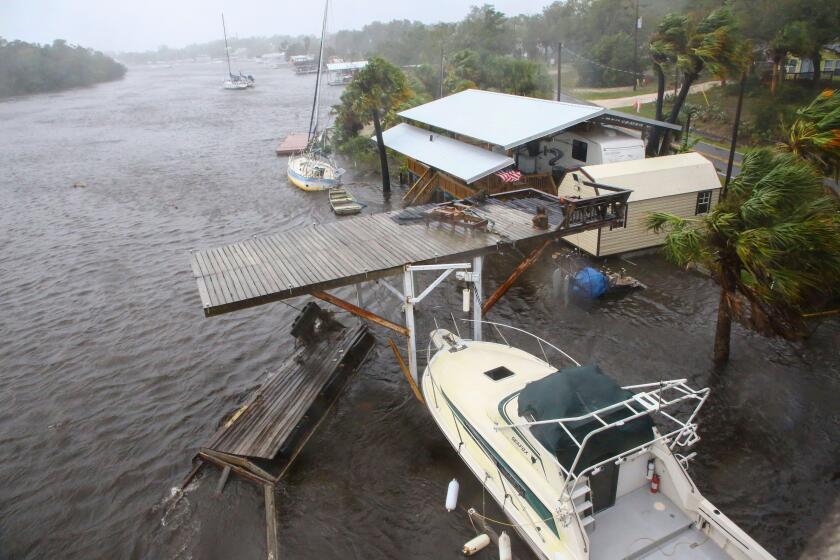What we know so far suggests that for the London market and reinsurers, the storm will be another minor irritant which vindicates the changes these players have made to control binders’ exposure closely and minimise attritional cat risk taking, especially from minor-tier insurers.
After a multi-year period of elevated cat losses in which reinsurers and the London market were heavily overweight in their share of claims, Idalia is likely to continue the H1 theme of losses being “upstreamed” to the primary/domestic market. During the first half of 2023, nat-cat losses reached $43bn, or 26% ahead of decadal averages, Munich Re has estimated. Nevertheless, reinsurers have delivered strong results over this period given the skew to retained losses.
At the low end, some sources believed Florida losses could be as low as $2bn-$3bn, while others were still in line with the over/under $5bn levels discussed earlier in the week. Some suggested that when taking into account scope for losses across Georgia and South Carolina, as well as the Florida litigation factor, an ultimate loss tally could creep up to around the $10bn mark.
All sources stressed a high degree of uncertainty given the early stage of assessing the loss.
But the overall picture remains one of a minimal Category 3 hurricane event for (re)insurers.
Early loss sentiment
As the storm was approaching land, sources had grown more comfortable that the projected track would minimise insured losses in Florida, reinforcing the view of it as largely a retained event for domestic carriers.
They repeatedly emphasized the low insured values at risk in the Big Bend region, which was generally seen as the best place a hurricane could hit an already stressed Florida insurance market.
Idalia became the strongest storm to hit the region in the past 125 years, making landfall near Keaton Beach at 120 mph – almost at Cat 4 level. The storm was expected to retain hurricane strength by the time it arrived in Georgia.
The Big Bend counties make up a tiny portion of the state’s population, and sources suggested it also lacked the high-value residential and commercial property seen elsewhere in the Sunshine State.
Pre-landfall modelled loss scenarios for Idalia had dropped ahead of the landfall as the storm’s track became more favourable, with Moody’s RMS mean scenarios dropping by several billion over the course of three days to $6.3bn, as this publication reported. The wind-only figures do not represent the firm’s loss estimate for the storm and are based on similar fit scenarios only.
Ahead of landfall, Gallagher Re said the event was shaping up as a low single-digit billion loss, while BMS Re said losses should be in the $3bn-$6bn range.
Moreover, there are hopes that stringent legal reform in Florida should help local insurers resist “leakage” of water claims to residential wind policies, although storm surge would more likely be covered by commercial property.
There are some ongoing points of concern for (re)insurers about handling the loss. Although headline inflation has settled back since last year, as Gallagher Re noted, Florida inflation is running at nearly double the US average.
If the storm does have a major impact to higher-value Georgia and South Carolina urban areas such as Savannah and Hilton Head or Charleston, this will impact a different insurer base than the Floridians, with a larger share of nationwide carriers who have higher reinsurance retentions.
But this has weighed less in the minds of market participants, so far, than the highly favourable initial track taken by the storm.
London defences to an Idalia loss
Hurricane Idalia will reinforce a sense of justification for reinsurers, who pushed hard to lift retentions this year to ensure that they were covering more remote risks, not the kind of cat events that are now seen as more routine and becoming attritional events for insurers to manage.
Where some reinsurers have still participated in first-layer Florida risk, these are at punitive rates that effectively mean cedants have prepaid for their first losses. Some insurers could have already had hail claims that could have also impacted first-layer reinsurance, which could be a further irritant to reinsurers in a year of high minor losses, if not a major concern.
Low exposure to Idalia on the primary side also highlights the retraction that London market insurers have made from US binders and other cat-exposed insurance, which had already been highlighted in Ian last year. Lloyd’s in particular has made efforts in recent years to dial back on peak US cat risk, after pressure from ratings agencies.
“A few Demotech[-rated] companies might be affected, but for London it’s not a big loss – US cat exposure has been really dialled back,” one source noted.
In Florida, remaining binder exposure tends to be south-east heavy and low on residential exposure, sources noted. “When the conditions have been so good, you've had your pick of accounts – and it’s tough to make the case for a Florida homeowners’ binder in those circumstances.”
There will be isolated pockets of possible direct and facultative (D&F) claims. One source noted that Disney BI claims would be expected for this type of event, but to date, sources have not raised major concerns about significant exposures.
Knock-on implications
Idalia’s timing – arriving less than a fortnight before the Monte Carlo Rendez-Vous and the start of the 1 January cat reinsurance renewal season – has naturally led to speculation around the impact of the storm on pricing negotiations.
It is important to repeat that at this point, the storm’s loss quantum is unclear, given that it made landfall less than 24 hours ago. Sources have, however, offered their opinions on its impact, assuming Idalia causes an industry loss of $10bn or less.
In bald terms, sources were clear that Idalia will be a relatively small treaty loss and that this storm alone will not set the agenda for 2024 cat reinsurance pricing.
As one source put it, it will be difficult for reinsurers to argue for price increases off the back of a loss that will be largely retained by cedants. This is particularly relevant given the recent overhaul of reinsurance programmes in Florida, the wider US and internationally, to increase retentions.
On the other hand, however, many sources said Idalia, taken together with other US and global cat losses this year, including ~$3.5bn of Hawaii wildfire losses, will help reinsurers to maintain discipline through the 1 January renewal.
Sources said that after the vast increases paid last year by Floridian carriers – and to a lesser extent many other US and global cedants – there had been early talk of a flattish renewal at 1 January and mid-2024.
While there was no expectation of a “knee-jerk” pricing reaction or large increases, sources now anticipate that Idalia will add to the list of mid-sized losses that made old reinsurance structures uneconomical to write.
“[Idalia] reminds everyone that hurricanes make landfall in Florida,” one source said, adding that Floridian cedants have already racked up losses from hailstorms in April and still have the worst of the hurricane season ahead of them.
Reinsurers were already set to base their case for continued rate increases on storms and flooding in Australia, New Zealand and elsewhere in the US, as well as the Canadian and Hawaiian wildfires, and Idalia will only add weight to their argument, sources said.
“[Idalia] won’t be a gamechanger on rate and create 40% increases, but until now people were talking about next year’s rates being flat to up 5%,” one source said.
Despite restructured Floridian programmes and increased retentions worldwide at the most recent few renewals, Florida cedants still buy relatively low-attaching programmes to meet Demotech solvency requirements.
Idalia is expected to eat into at least some first and even some second layers of programmes. Should cedants experience another significant hurricane loss this season, there could be demand for additional top-up or back-up coverage before the policy year is out, particularly on a sideways basis, sources said.
Whether reinsurers have the appetite to provide that coverage remains questionable, however. While the rate increases seen in the past two Florida renewals may tempt more reinsurance capital into the state, sources said it is more likely that reinsurers will sit on their hands for at least the period immediately following the storm.
On the primary side, sources suggested that the loss will also help to support carrier resolve on pricing.
One source said that despite strong compound rate growth in the London D&F market, there was a sense that discipline was beginning to give way – but that Idalia will help to prevent that.
Another added that a clean North American wind season may have made their plans for low- to mid-single-digit rate increases on D&F in 2024 difficult to achieve, but that Idalia will strengthen insurers’ case.




